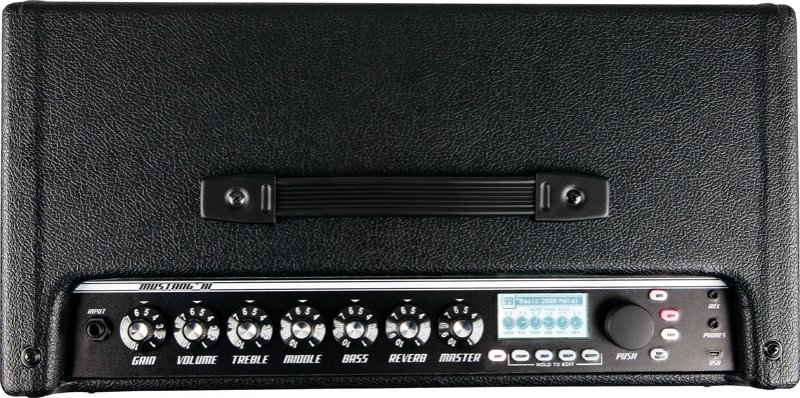Gear Review: Fender Mustang III (Version 2) Modelling Guitar Amp
Gear Review: Fender Mustang III (Version 2) Modelling Guitar Amp
Fender are pretty good at what they do best and have been for a long time now – building industry-standard valve amps and classic electric guitars by the thousand. But time, as the Rolling Stones astutely pointed out, waits for no-one, and, to quote another legend and survivor of the ’60s, the times they are a-changing.
While valve amplifiers still remain the holy grail for most professional musicians, digital modelling amps have been with us for well over a decade now and very smart designers have been steadily ironing out the sonic bugs that made it easy for valve-snobs to be so dismissive of them. As they got better they began to gain a solid foothold in the lucrative average Joe market through brands like Line 6, Peavey and Vox, to the point where a large and seemingly unassailable corporate entity like Fender had to sit up and take notice, and eventually embrace the technology or risk being left behind.
Enter the Fender Mustang (cue pounding hooves and snorting). No, not the stylish six-string Fender axe so beloved of callow, shoe-fixated youths, but a five-model stable of digital amps consisting of 20 and 40 watt basic models (1 and 2), 100 and 150 watt combos (3 and 4), the latter being a 2 x 12 stereo version, and the 150 watt stereo head and 4 x 12 cabinet (5).
The version well be looking at this issue is the 100W combo (Mustang III, version 2) which comes loaded with a single 12 Celestion and an rrp of just a snitch under $700. It sits nicely in the middle of the range and is likely to give a good indication of what we can expect from Fender’s foray into the digital realm.
Due to the absence of valves and transformers the Mustang III is a very compact (52 cm x 45 cm x 27 cm) and lightweight (16 kg) unit for a 100W amp. There’s the familiar silver-flecked grille cloth that has graced thousands of its valve ancestors, and a very clean and simple front panel consisting of Gain, Volume, Treble, Middle, Bass, Reverb and Master Volume knobs.
The amp modelling and digital effects section is simplicity itself, both visually and operationally, consisting of nine illuminating push buttons, a rotary knob and a reasonably sized LCD screen. There’s an 1/8 inch Auxiliary Input jack socket for a media player and a headphone input, while the back panel features inputs for the 2 or 4-button (or both) footswitches, the former (included) allowing you to step up or down through the 100 presets, while the 4-button has a Mode switch allowing you to group presets into Banks and step up or down through them, or alternatively switch Modulation, Stomp or Delay effects on or off. There are two balanced Line Outputs left and right, a Ground Lift button and an FX Loop Send and Return.
And being a digital amp there is the now mandatory USB port, this one for accessing Fender’s Fuse software. This opens up deeper editing of the amps and effects via an excellent graphic interface, allowing you to store unlimited presets, sort and play along with MP3s and also accesses the community website where you can download free presets from Joe Blow or even Johnny Marr or Jeff Beck. You can even make your own multi-track recordings via the Ableton Live Lite 8 Fender software, a real deal-sweetener I reckon.
Getting started is a no-brainer; plug in, turn it on and turn up the Master Volume, but not too far or you’ll give yourself a hell of a fright – 100 watts is not to be trifled with in a small room. The 100 factory presets are a great way to get a feel for the scope of sonic possibilities this amp represents, nearly all being quite useable and covering a wide variety of genre-appropriate sounds.

There are 12 amp models on offer here, with classic Fenders like the Bassman, 57 Deluxe, 65 Twin, Princeton, and 57 Champ unsurprisingly taking the lion’s share of the action. But you also get some pretty handy Marshall, Vox and American metal emulations thrown in for a bit more diversity. On the effects side there are seven stomp effects such as compressors, overdrives, distortions and fuzz, 11 modulation effects including chorus, flanger, intelligent pitch shifting, vibratone, tremolo, phaser, wah (only with optional expression pedal), step filter and more, plus nine delay types (mono, multi-tap, ping pong, tape etc) and 10 reverb options.
The editing process is so intuitive that anybody familiar with using digital effects shouldnt need to go near the manual. Want to change the amp gain on your preset? Okay, concentrate… Turn the Gain knob and press the Save button when you’re happy. Editing effects is similarly straightforward. Want to swap that Rat Distortion for a Tube Screamer overdrive? Press the Stomp button and use the scroll knob to check out the possibilities, if you then want to change a parameter in that pedal, press and hold the Stomp button while turning the scroll knob – this will cycle through the various editable parameters – represented as virtual knobs on the display. When you have your parameter (it will be filled in black), release the Stomp button and use the Scroll knob to tweak, then push Save when youre happy. It’s beautifully simple and yet gives the user a high degree of control over the effects section.
Of course all this user-friendliness doesn’t amount to much if the sound doesn’t cut it, and I’m pleased to say that I was very impressed by the sheer quality of both the amp models and digital effects. There was zero latency detectible from pick to ear drum and all the personality that you would normally expect from real valves – clean tones really sparkled without any of the brittleness common to early modelling amps, the guitars tonal signature was never obscured by amp or effect colouration, and just like a true valve amp there was real responsiveness to pick attack, cleaning up nicely in distortion or overdrive mode during lightly played passages. Even changing the right hand position from neck to bridge was instantly discernable in the overall tone.
Scrolling through the factory presets gives a good indication of the sheer versatility of the Mustang, with something on offer for every genre imaginable, whether it’s a bluesy growl, country twang, rockabilly slap-back, glistening ‘80s chorus or ’70s rock crunch. The only area that came across a little under-served was modern metal, with both the British and American stack emulations lacking a little of the dense darkness that players of this genre would be looking for. That said, the addition of a specialist metal pedal would go a long way to alleviating that shortcoming, so I wouldn’t discount this Mustang from acquitting itself pretty handily at the heavier end of the spectrum too.
In summing up, the Mustang III is an extremely versatile, lightweight yet powerful combo that represents very good value for money in that you get a variety of different amps and great-sounding, editable effects in one easy to operate package, with the added bonus of a computer interface and multi-track recording.
Modelling technology has come a long way in the last few years (check out the new Kemper amps online and be amazed), so if you’ve shied away from digital amps in the belief that the sound just won’t cut it, now might be a good time to revise that assumption. Take a Fender Mustang out for a test drive. My guess is that you’ll return to the showroom with a big smile on your dial.
